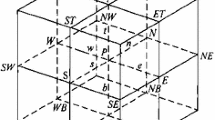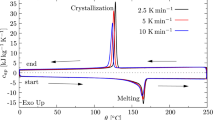Abstract
The pressure flows of a thermoplastic elastomer vulcanizate (TPV) melt through the die region of a single-screw extruder were simulated using the finite-element method. The COMSOL software was utilized to develop the finite-element model of the die and solve the working equations. ACross-WLF rheological equation of state was used for the description of the rheological behavior of the polymer melt. The numerical results were compared with their associated experimental data. The novel aspect of the present work is the development of a new augmented Navier’s slip equation to take the effect of wall slip on solution variables into account. The proposed model consists of a power-law equation, which relates the slip coefficient to the shear rate at wall. It is implemented in the COMSOL code through a simple script. The distribution of the velocity, pressure, and temperature as well as the profile of the fluid velocity at exit region and slip velocity along the flow directions were presented and discussed. It has been shown that using the no-slip condition at wall or employing the Navier’s slip equation with a constant slip coefficient leads to notable error in the prediction of mass flow rates and pressure.
Graphical abstract












Similar content being viewed by others
Data availability
Data sets generated during the current study are available from the corresponding author on reasonable request.
References
Nassehi V (2002) Practical Aspects of Finite Element Modelling of Polymer Processing, 1st edn. Wiley
Nassehi V, Ghoreishy MHR (1997) Simulation of free surface flow in partially filled internal mixers. Int Polym Process 12:346–353
Ghoreishy MHR, Nassehi V (1997) Modeling the transient flow of rubber compounds in the dispersive section of an internal mixer with slip-stick boundary conditions. Adv Polym Technol J Polym Process Inst 16:45–68
Silliman WJ, Scriven LE (1980) Separating flow near a static contact line: slip at a wall and shape of a free surface. J Comput Phys 34:287–313
Ghoreishy MHR, Razavi-Nouri M, Naderi G (2000) Finite element analysis of flow of thermoplastic elastomer melt through axisymmetric die with slip boundary condition. Plast Rubber Compos 29:224–228
Lau HC, Schowalter WR (1986) A model for adhesive failure of viscoelastic fluids during flow. J Rheol 30:193–206
Hatzikiriakos SG, Dealy JM (1991) Wall slip of molten high-density polyethylene. I. Sliding plate rheometer studies. J Rheol 35:497–523
Hatzikiriakos SG (2012) Wall slip of molten polymers. Prog Polym Sci 37:624–643
Archer LA (2005) In: Hatzikiriakos SG, Migler KB (Eds) Polymer Processing Instabilities, Control and Understanding. Marcel &Dekker, New York
Matthews MT, Hill JM (2007) Newtonian flow with nonlinear Navier boundary condition. Acta Mech 191:195–217
Thompson PA, Troian SM (1997) A general boundary condition for liquid flow at solid surfaces. Nature 389:360–362
Pérez-Salas KY, Ascanio G, Ruiz-Huerta L, Aguayo JP (2021) Approximate analytical solution for the flow of a Phan-Thien–Tanner fluid through an axisymmetric hyperbolic contraction with slip boundary condition. Phys Fluids 33:053110
Wilms P, Wieringa J, Blijdenstein T, van Malssen K, Hinrichs J, Kohlus R (2020) Wall slip of highly concentrated non-Brownian suspensions in pressure driven flows: A geometrical dependency put into a non-Newtonian perspective. J Non-Newton Fluid Mech 282:104336
Yang C, Li Z (2014) A study of wall slip in the capillary flow of a filled rubber compound. Polym Test 37:45–50
Yang C, Li Z (2016) Effects of wall slip on the rheological measurement and extrusion die design of a filled rubber compound. Plast Rubber Compos 45:326–331
Rippl AP (2004) Three-dimensional simulation of rubber profile extrusion on the basis of in-line rheometry. Swansea University (United Kingdom)
Mitsoulis E, Battisti M, Neunhäuserer A, Perko L, Friesenbichler W, Ansari M, Hatzikiriakos SG (2017) Flow behaviour of rubber in capillary and injection moulding dies. Plast Rubber Compos 46:110–118
Bird RB, Stewart WE, Lightfoot EN (2006) Transport Phenomena, 2nd edn. John Wiley, Inc
Shi XZ, Huang M, Zhao ZF, Shen CY (2011) Nonlinear fitting technology of 7-parameter cross-WLFviscosity model. In: Advanced Materials Research. Trans Tech Publ 2011:2103–2106
COMSOL Multiphysics, Ver. 6.0, COMSOL Inc.,
Origin software, Ver. 6.1, 2000
Acknowledgements
The authors would like to acknowledge the Iran Polymer and Petrochemical Institute for permission to publish the results presented in this paper.
Author information
Authors and Affiliations
Corresponding author
Supplementary Information
Below is the link to the electronic supplementary material.
Rights and permissions
Springer Nature or its licensor (e.g. a society or other partner) holds exclusive rights to this article under a publishing agreement with the author(s) or other rightsholder(s); author self-archiving of the accepted manuscript version of this article is solely governed by the terms of such publishing agreement and applicable law.
About this article
Cite this article
Ghoreishy, M.H.R., Sourki, F.A. Computer simulation of the flow of a thermoplastic elastomer vulcanizate melt through an axisymmetric extrusion die using an augmented Navier’s slip equation. Iran Polym J 32, 1101–1110 (2023). https://doi.org/10.1007/s13726-023-01190-9
Received:
Accepted:
Published:
Issue Date:
DOI: https://doi.org/10.1007/s13726-023-01190-9




